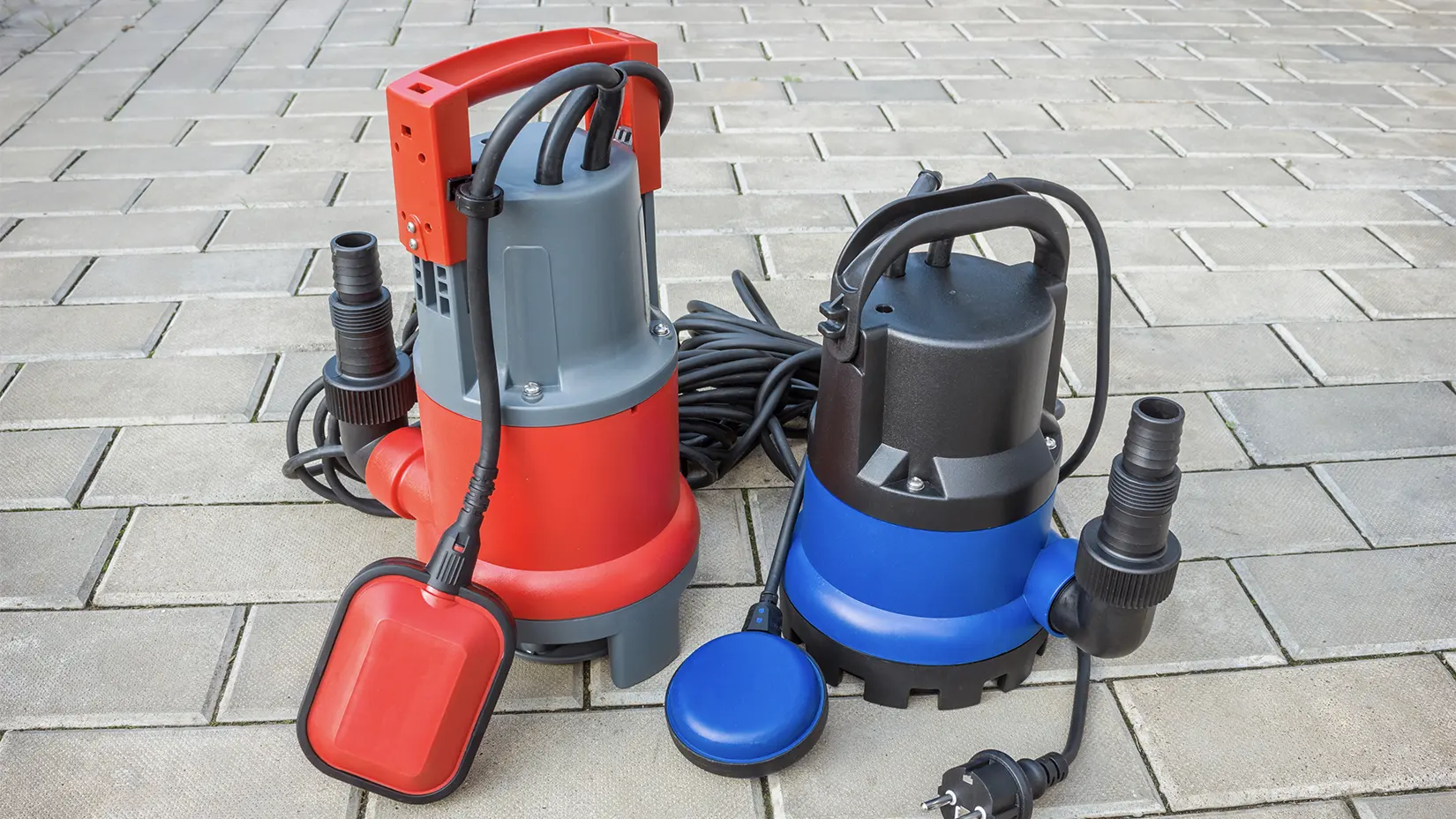
A sump pump is a pump that channels water out of a basement to the exterior of a building. These pumps help reduce the likelihood of flooding, decrease the chances of mold growth, and can help protect the structural integrity of a building’s foundation.
Understanding what to do when there's water in a basement is important for maintaining a safe environment and good property management. According to the Insurance Information Institute, the average cost of flood damage for homeowners over a four-year period exceeds $12,000 annually. Water damage not only causes financial loss but can also cause health problems due to increased mold and mildew growth. While there is no way to completely prevent flooding, a sump pump in the basement can significantly reduce the likelihood that a basement will flood.
A sump pump directs water out of a basement and away from the foundation. A properly installed and maintained pump helps maintain safer below-ground wetness day-to-day and removes excess water caused by rain storms or other weather-related events.
The differences between pump types, how to choose the right pump, the pros and cons of using a sump pump, and alternatives to these types of pumps are all important factors when managing or maintaining a building.
Table of contents:
What Is a Sump Pump?
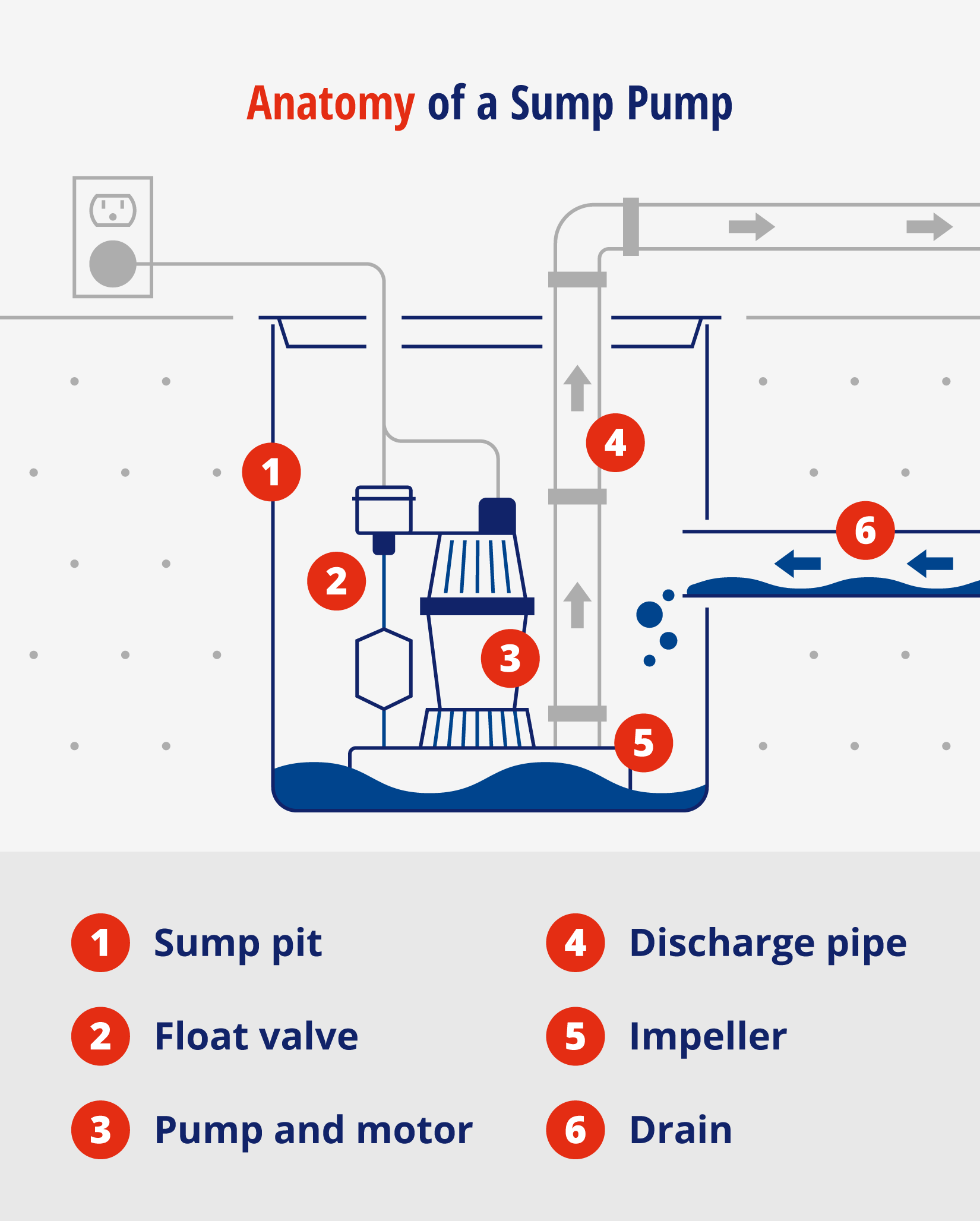
A sump pump is a device designed to remove water from a basement and expel it to the exterior of the building. These pumps are installed in a sump pit, a basin dug into the lowest area of a basement. When water accumulates, the float valve activates the motor on the pump, which then pumps the water out of the basement through a discharge line.
For buildings prone to flooding, sump pumps are an essential piece of equipment. They can help:
- Protect the structural integrity of a building
- Reduce the risk of (and damage from) flooding
- Limit the growth of mildew and mold
Who Needs a Sump Pump?
When a building is located in an area that receives a lot of precipitation or is prone to flooding, installing a sump pump is a good idea. A sump pump can even be useful in desert areas where moisture is rare because it can help remove water from a basement during a flash flood. Here are several other examples of when a building should have a sump pump:
- Buildings located on land that is prone to flooding. Buildings built in low-lying areas or on soil that doesn’t drain well can increase the chance of flooding.
- Buildings that have flooded before. A past flood is a good indicator that a basement could flood again. Installing a sump pump will decrease the chance of flooding by directing groundwater away from a building.
- Commercial properties with basements. Because most of the critical infrastructure of a commercial building is located in the basement, investing in a sump pump can save commercial property owners money and prevent damage that could shut down the business for an extended period.
- Buildings that have a finished basement. While every basement will benefit from a sump pump, any building with a finished basement definitely needs a sump pump to prevent flooding and costly flood damage.
How Does a Sump Pump Work?
For a sump pump to work correctly, it needs to be in a hole (called a sump pit) in the basement. The sump pit should be approximately 18 inches deep and 24 inches wide. Most pumps also need an electrical outlet nearby to supply the pump with power (though many sump pumps have battery- or water-powered backups in case of an outage).
- When the pump is in place, water activity, including rising levels of groundwater and water moving into the pit, will activate the float switch.
- When the switch is triggered, the pump turns on, and the water is discharged through a pipe that runs out of the building to a safe drainage site (usually 10-20 feet away from the foundation).
- A check valve at the end of the pump prevents the water from re-entering.
- When the water level drops below a certain threshold, the pump turns off automatically.
The Benefits of a Sump Pump
Flooding can be one of the most dangerous, damaging, expensive, and time-consuming problems to deal with. That’s why having a sump pump in the basement is such a good idea. Here are more benefits of installing a sump pump:
- Prevents flooding
- Reduces the risks of mold and mildew
- Protects the foundation
- Mitigates risk of electrical fires
- Provides peace of mind for property owners and businesses
The 5 Types of Sump Pumps
Not all sump pumps are the same. Some are designed to work best for large buildings in areas prone to heavy flooding, while others are built to handle flooding in lower-risk areas. There are also several different types of backups for these pumps in case of a power outage or device malfunction.
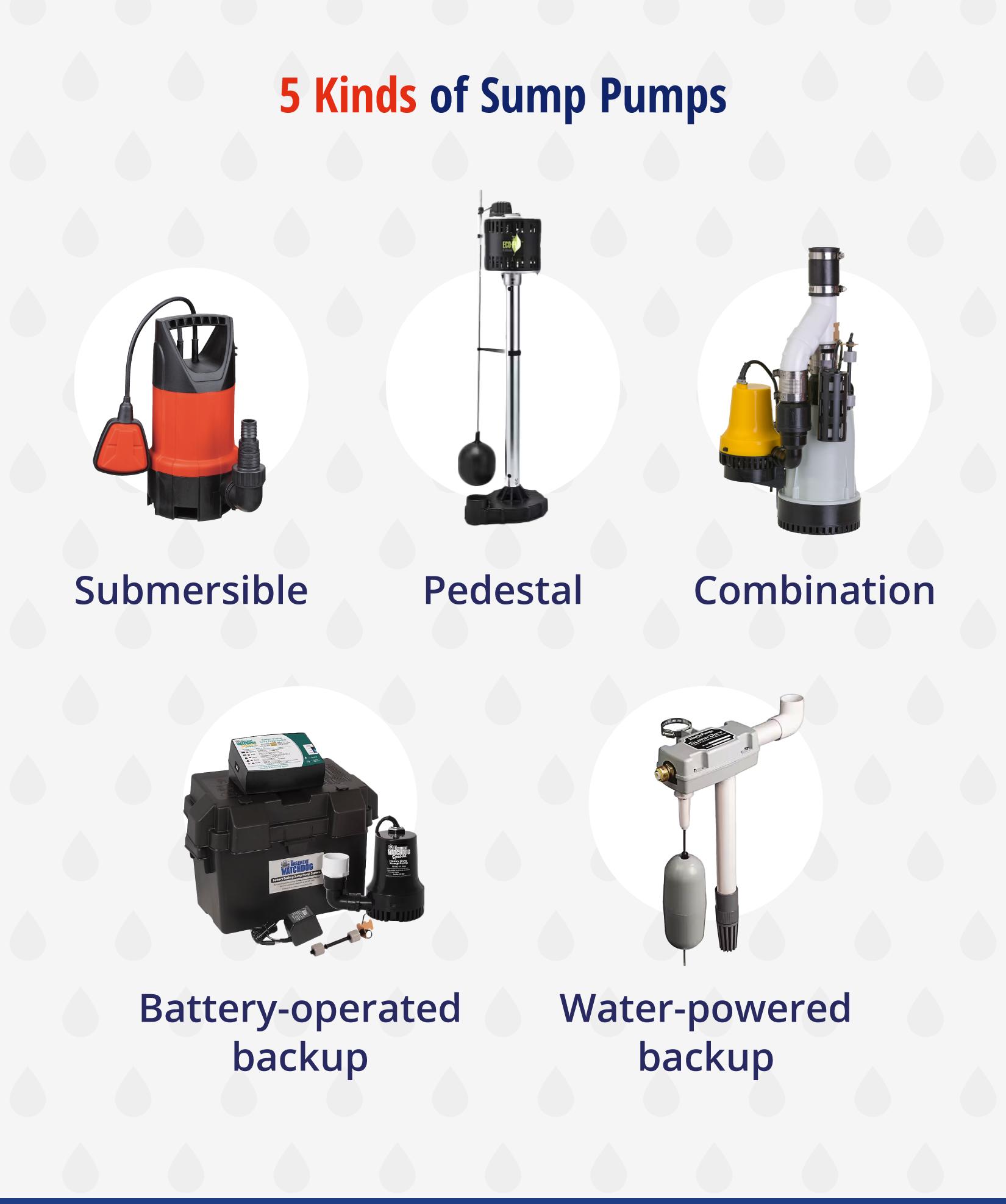
Here is a more is a more detailed explanation of how each type of sump pump works:
Submersible Sump Pumps
A submersible sump pump is designed to be placed at the bottom of a sump pit. It functions when submerged in water. Due to its design, these pumps are quieter and more efficient than other types of pumps. These features make them a good choice for buildings that are susceptible to significant water accumulation.
Submersible sump pumps typically last longer than other pumps but are usually more expensive.
Pedestal Sump Pumps
These sump pumps feature a pedestal that sits in a sump pit with a motor mounted at the top. A hose carries the water outside of the building. A pedestal pump is more visible, doesn’t pump as much water as quickly, and takes up more space than a submersible pump. One advantage of a pedestal pump is that it is easier to maintain because the motor isn't submerged.
This pump type works best in smaller spaces and buildings with minimal flood risk.
Battery-Operated Backup
A battery-operated backup is not a distinct type of sump pump but an optional add-on for other types of sump pumps. If the power goes out, a sump pump will stop working unless it has a backup. Battery backups are designed to turn on when the power fails.
A battery backup is essential for areas prone to power outages and heavy rainfalls.
Water-Powered Backup
This type of power backup uses municipal water entering a building to power a sump pump when the power goes out. These backups use pressure from the municipal supply to create suction that draws accumulating water out of a basement. These backups can’t be used if a building draws its water from a well.
These backups can work indefinitely, but they are less powerful than a battery-operated backup working at full capacity.
Combination Sump Pumps
A combination sump pump includes a battery backup, which means there is no need to purchase an additional backup power source. For buildings in areas prone to heavy storms and with a high water table, a combination sump pump may be the best choice.
What To Consider When Choosing a Sump Pump
Sump pumps are not one-size-fits-all devices. To choose the correct pump for your property, it’s important to understand how it functions, the conditions in a given area, the different kinds of switches used, and any space and budget restraints.
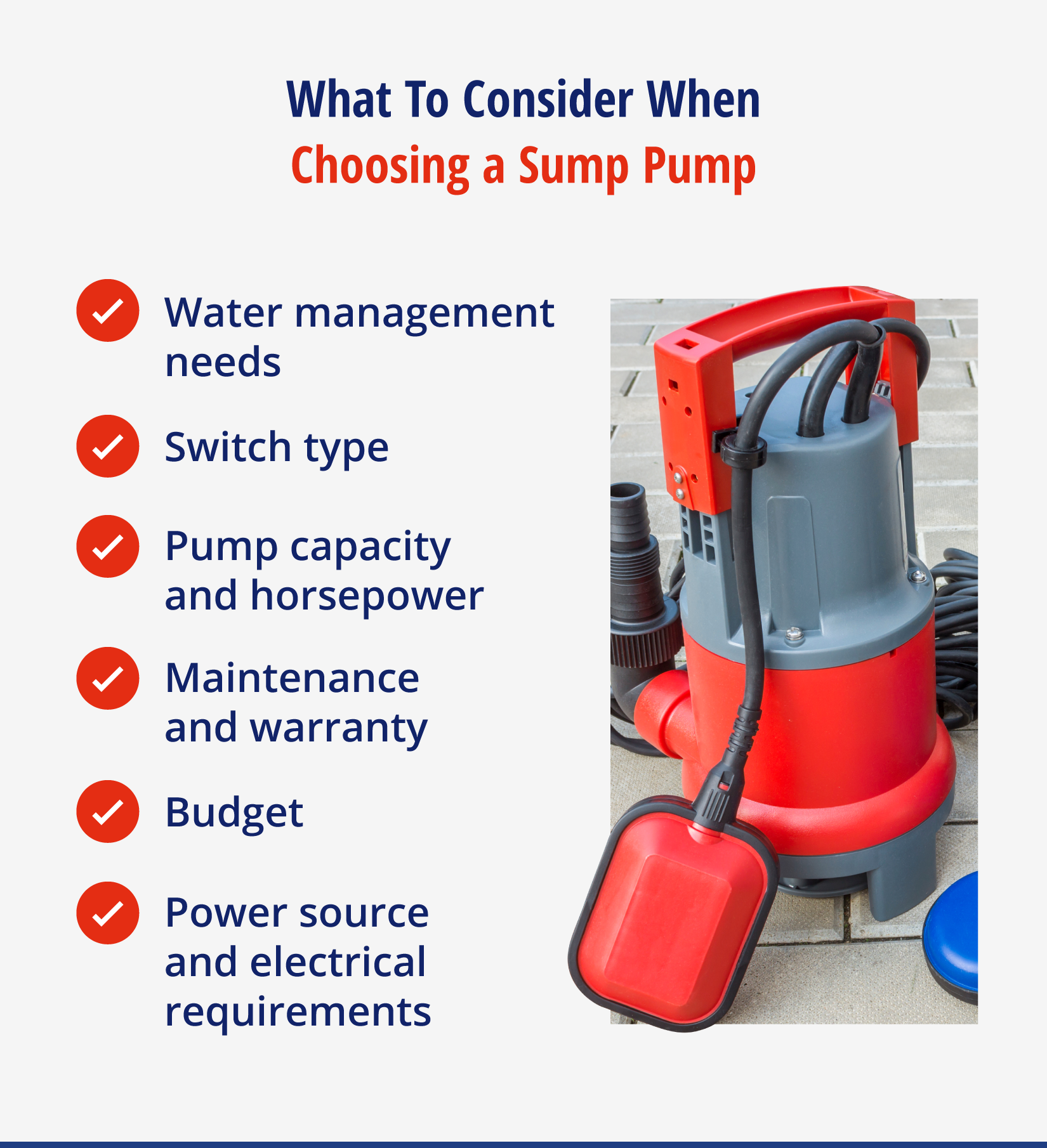
Water Management Needs
Different areas (even within the same town or city) may have vastly different water tables. That means what works for one building won’t necessarily work for another.
With a sump pump, it’s best to consider the worst-case scenario. For buildings in locales with frequent rain or high water tables, the sturdiest, fastest, and most reliable pumps may be necessary. Spending more on a sump pump now may prevent more costly flood damage in the future.
Sump Pit Size and Compatibility
Different types of sump pumps require different sizes of sump pits to function correctly. Submersible pumps generally need to be placed in deeper and wider pits than pedestal pumps, and are typically more expensive to install.
Switch Type
A sump pump switch is what triggers the pump to turn on. Pumps can be equipped with either an automatic or manual switch. The benefit of an automatic switch is, it will automatically turn the pump on when the water reaches a certain level. Meaning, in the event that a flood occurs when unoccupied, the pump will still do its job. There are several different types of automatic switches available, including:
- Tethered float switches: A float is attached to the pump. As the water level rises, the float rises and flips the switch on. Tethered floats are commonly used on submersible sump pumps.
- Vertical float switches: A float is attached to a vertical rod and rises as the water does. At a set level, it triggers the switch. Vertical floats can be used in tight spaces with pedestal sump pumps.
- Electronic switches: An electronic switch relies on an internal sensor instead of a float to detect water levels. When the sensor is triggered, the switch turns the power on to the pump.
Pump Capacity and Horsepower
Pump capacity is measured by the number of gallons of water per minute (GMP) or gallons of water per hour (GPH) the pump can discharge. Larger basements in areas with higher levels of rain will need higher-capacity pumps to keep the basement from flooding.
A sump pump's horsepower is also crucial. Pumps with more horsepower are ideal for situations that require pumping more water vertically.
Power Source and Electrical Requirements
Almost all sump pumps require electricity to run, but depending on their capacity, they may need more power than a standard electric outlet can provide.
It’s also important to consider the length of the sump pump’s power cord when choosing where to place the pump and sump pit. The location of the pump should be close enough to the pit that it won’t require an extension cord but not so close that it’s at risk of getting wet.
Maintenance and Warranty
Sump pumps are designed to last, but they still need to be maintained. Check the pump for signs of damage and conduct regular testing to make sure it works properly.
The warranty on a pump is another factor to consider when making a purchase.
Budget
Choosing a cheaper sump pump for a property may be tempting, especially if there is no history of flooding, but investing in a reliable, high-quality pump can save more money in the long run by preventing costly flood damage.
Some factors that can impact the cost of installing a sump pump include:
- Type of pump
- Floor material
- Drainage
- Permits
- Installation
Consult with a professional to learn about the different sump pump options available. They can provide valuable advice based on their experience along with knowledge of local conditions.
When To Replace a Sump Pump
Regular maintenance can prolong the life of the pump. Most sump pump problems become evident during regular maintenance and testing. Here are a few things to consider when assessing sump pump longevity:
- The age of the pump: Most sump pumps are rated to last around 10 years, though some will work longer.
- Irregular operation: Pumps that aren’t tested regularly or rarely activated can fail sooner than pumps that run frequently.
- Continuous operation: If a pump is running all the time, it could put stress on the motor and shorten its lifespan. Continuous pumping could also mean there is something wrong with it.
- Strange noises: When a sump pump starts making thumping, grinding, or whirring noises, it could be a sign it needs to be replaced.
- Rust or corrosion: Because these pumps are made with materials designed to resist corrosion, any rust is a sign that it’s time to get a new one.
- Motor failure: If a motor fails during a flood or test, the sump pump needs to be replaced as soon as possible.
- Inadequate water removal: Compare current pumping capacity to past performance. If there is a significant drop, consider repairing or replacing the sump pump.
- After major flooding: Flooding lasting many hours or days could be enough to burn out the motor. To avoid putting a basement at risk, replace pumps that have worked overtime for an extended period.
- After a failed inspection: Routine inspections by restoration and flood prevention experts can uncover hidden problems. If they suggest replacing a unit, it’s a good idea to listen.
- Be proactive: Replacing pumps before their warranties expire is a good way to prevent failure.
Sump Pump Alternatives
While sump pumps are a common solution for addressing basement water problems, there are other alternatives worth considering. Weigh sump pumps against these other options to determine the best protection for a home or commercial building.
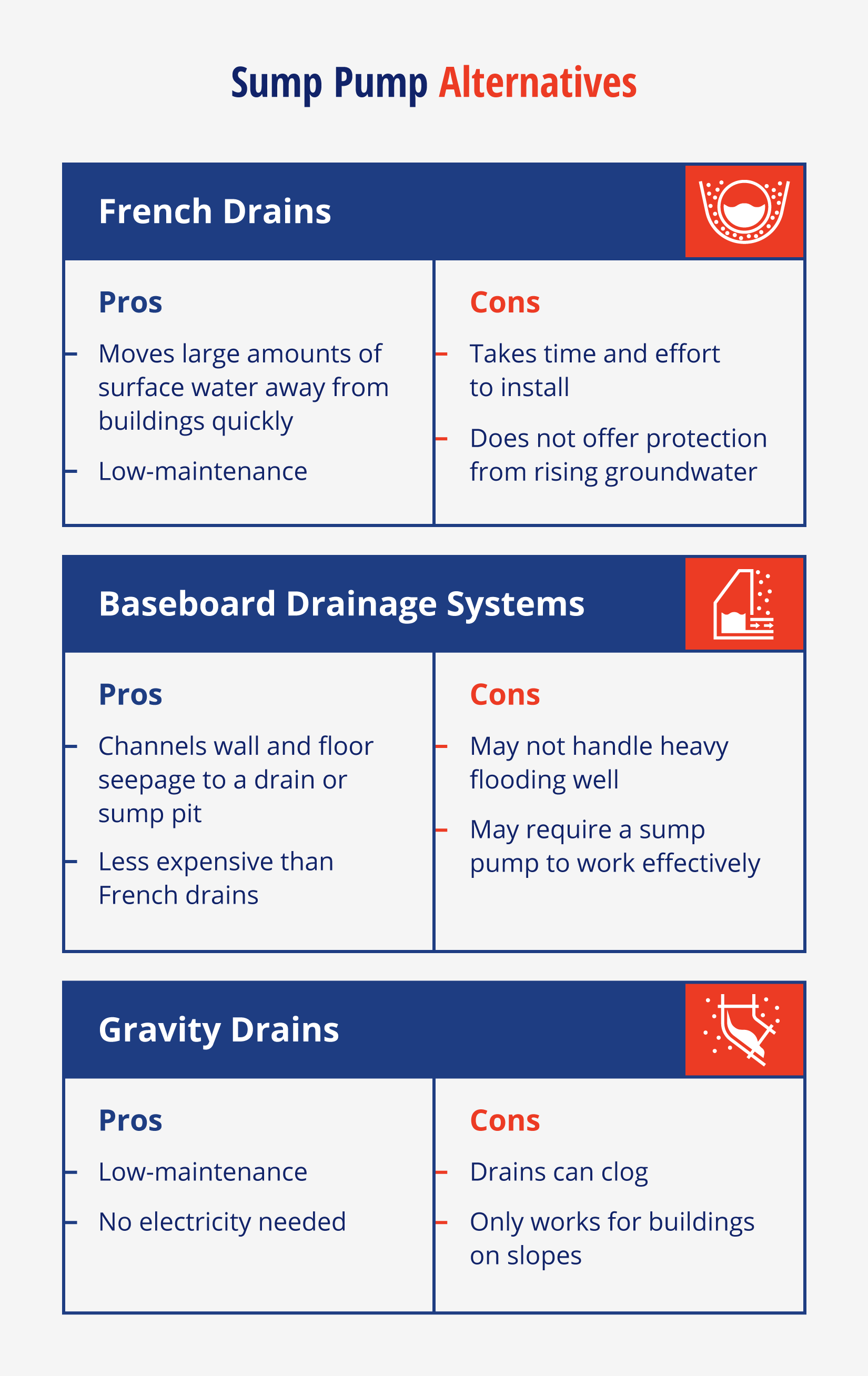
French Drains
French drains are trenches with a perforated pipe covered with gravel. The pipe redirects surface water away from the foundation of a building to reduce flooding and foundation damage.
These drains need very little maintenance and can stop large amounts of water from leaking into a basement.
However, installing a French drain is labor-intensive. It may require grading the area around a building, digging a trench, and bringing in large amounts of gravel. French drains also offer less protection from groundwater than sump pumps.
Baseboard Drainage Systems
A baseboard drainage system is a drain channel installed around the outer perimeter of a basement. It channels water seeping through walls and floor joints and directs it to a drain or sump pit.
Installing a baseboard drainage system is usually easier and less expensive than a French drain but it may still need a sump pit and pump to effectively force water out of a basement.
These systems are not designed to handle heavy flooding and may offer little relief during a heavy storm.
Gravity Drain
If a building is on a slope, the grade can draw water down and away from the foundation using a gravity drain. These systems don’t need electricity to function, and they require very little maintenance (other than keeping the drain clear).
This type of drainage system only works if the slope is steep and long enough. Gravity drains also don’t work as well as sump pumps during heavy storms, and debris like leaves and dirt can clog the drain, leading to backed-up water.
Flood Preparation and Prevention
In areas where flooding is frequent or severe, taking steps to mitigate flood risks can save time and money and may even prevent major flood damage. Take these proactive steps to stem the tide before the next big storm:
- Understand the flood risk in your area.
- Pick a sump pump that can handle a worst-case scenario.
- Implement waterproofing measures around your property.
- Improve drainage around the foundation of your home or commercial building.
- Inspect and reinforce exterior elements that could help reduce flood risks.
- Elevate electrical systems and appliances to keep them out of a potential flood zone.
- Stay informed about storms and any changes in the weather that could cause flooding.
Frequently Asked Questions Sump Pumps
Here are answers to some of the most frequently asked questions about sump pumps.
Do All Houses Have a Sump Pump?
Not all homes or commercial buildings have a sump pump. If a building doesn’t have a basement or is in an area with low levels of rain, it may not need a sump pump.
What Is the Purpose of a Sump Pump?
The purpose of a sump pump is to remove excess water from the lowest point in a building. It is usually placed in a shallow pit dug into the ground in the basement, where it can pump water away from the foundation.
How Often Should a Sump Pump Run?
Sump pumps should only run when the water levels trigger the pump. They are not designed to stay on all the time. However, if there is frequent or heavy precipitation, a sump pump may run regularly, even several times a day.
What Are the Negatives Associated With a Sump Pump?
There are a few possible drawbacks to a sump pump.
- If these pumps aren’t maintained, they may not work as well as they should, potentially causing flooding.
- If a sump pump is undersized, it may not have the capacity to pump water out of the sump pit fast enough, which can result in flooding.
- Most sump pumps require electrical power, which means an outlet needs to be nearby.
- Digging a sump pit may allow higher levels of radon gas to enter a building.
Need Help Dealing With Water Damage?
Even when taking all of the right preventative measures and maintenance, flooding can still occur. If your property has already been exposed to flooding and suffered water damage, professional help is just a call away. Your local Rainbow Restoration® has an experienced team of water damage restoration experts who will get your property back to its best possible condition. Contact your local Rainbow Restoration to discuss water damage restoration services that will help you and your property recover from water damage.
This article is intended for general informational purposes only and may not be applicable to every situation. You are responsible for determining the proper course of action for your property. Services should be performed by licensed and experienced professionals. Rainbow Restoration is not responsible for any damages that occur as a result of this blog content or your actions. For the most accurate guidance, contact a Rainbow Restoration professional for a custom, on-site assessment.

